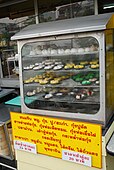Food warmer

A food warmer is typically a table-top device used to maintain the serving temperature of prepared food. It is used both in homes and restaurants.
Home use
When used domestically, such as with fondue, a food warmer may simply be a small vessel containing food upon a trivet which contains a heat source such as a flame or electric element.
Some food cookers can then, in essence, become food warmers as they use a reduced heat to maintain a serving temperature.[1] Electric rice cookers do this automatically. A multicooker is an electric kitchen appliance for automated cooking using a timer. In addition to cooking programs, a multicooker may have functions to keep food warm.[1]
Some electric-powered personal-sized food coolers have a setting that serves to warm food inside of the cooler.[2] These are typically marketed as cooler/warmers.[2]
Commercial use

Commercial food warmers are used in restaurants as well as outdoor food carts.
In restaurants and hotels they may operate the same way, but on a larger scale. Buffets commonly use large, stainless steel containers with a sterno fuel source. Restaurants also use steam tables to keep multiple vessels warm at once. These have a large, shallow body of water that is kept at a certain temperature with pans of food placed on top, typically rectangle stainless steel.[3] East Asia in particular uses steam tables in restaurants, and notably, portable ones to keep bamboo steamers containing dim sum dishes hot.
A flameless ration heater is a flameless chemical heater used to heat some types of Meal, Ready-to-Eat entrees.
List of food warmers
This is a list of food warmers. Some may also serve as cookers.
- Bain-marie
- Chafing dish
- Crock pot
- Fondue
- Multicooker – some have a warming setting
- Rice cooker
- Steam table
Gallery
- Food warmers
- A commercial food warmer
- An Austrian food warmer with insert, circa 1730-1735
- A 'Pyramid' food warmer invented by Samuel Clarke in England
- Grout's patent invalid's food warmer, England, 1871-1900
- A food warming cabinet, c. 1910, cast iron, Ante Room, Shugborough Hall, Staffordshire, England
- A flameless ration heater used for Meal, Ready-to-Eat
- A contemporary food warmer with various foods
See also
References
- ^ a b Kitchen, A.S.T. (2015). Healthy Slow Cooker Revolution. America's Test Kitchen. p. PT 41. ISBN 978-1-940352-21-3.
- ^ a b Melanson, Don (November 14, 2017). "The Road Trip Gadget Guide – 8 Gadgets For Hitting the Road". Popular Mechanics. Retrieved April 20, 2018.
- ^ Lynch, F.T. (2007). The Book of Yields: Accuracy in Food Costing and Purchasing. John Wiley & Sons. p. 130. ISBN 978-0-471-74590-7. Retrieved April 16, 2018.
External links
 Media related to Food warmers at Wikimedia Commons
Media related to Food warmers at Wikimedia Commons







